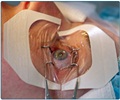Sunglasses have to be worn irrespective of the season, in order to protect eyes from the harmful effects of UVA and UVB radiation of the sun. Wearing sunglasses that block 99 to 100 percent of UVA and UVB radiation will offer adequate protection to the eyes.

‘Sunglasses need not cost a lot of money to provide adequate eye protection. Less expensive pairs marked as 100 percent UV-blocking can be just as effective at protecting eye health.’





The American Academy of Ophthalmology is working to debunk the myths and offer tips to promote smart eye health choices.Myth #1: Sunglasses are only for sunny days. False. UV light gets through clouds and haze. Regardless of the season, sun exposure can increase the risk of developing cataracts, growths on the eye and cancer. Sun reflecting off ice and snow can also lead to photokeratitis, a painful eye condition sometimes referred to as snow blindness.
Myth #2: Babies and children don’t need to wear sunglasses. False. Children are just as susceptible to the sun’s harmful rays as adults. Start them on healthy habits early.
Myth #3: Cheap sunglasses don’t offer protection. False. Sunglasses don’t have to cost a lot of money to provide adequate eye protection. Less expensive pairs marked as 100 percent UV-blocking can be just as effective as more expensive options. Labels can sometimes be confusing. Some indicate sunglasses offer 100 percent protection from UVA/UVB radiation, others offer 100 percent UV 400 protection. Both block 100 percent of the sun’s harmful radiation.
Myth #4: Size doesn’t matter. False. The more coverage sunglasses provide, the less sun damage inflicted on the eyes. Consider oversized sunglasses or wraparound-style glasses, which can help cut down on UV light entering the eye from the side. Wraparound glasses may also protect against dry eye due to the wind.
Advertisement
Myth #6: Darker lenses offer more protection from the sun. False. The darkness of the lens isn’t indicative of protection. Make sure the label on the lens says 100% UV-blocking.
Advertisement
“Your eyes need protection from the sun’s damaging ultraviolet rays just like your skin,” said Dianna Seldomridge, MD, clinical spokesperson for the American Academy of Ophthalmology. “Sunglasses are your prescription for eye health. They are effective, inexpensive, and provide protection year-round.”
Source-Newswise








